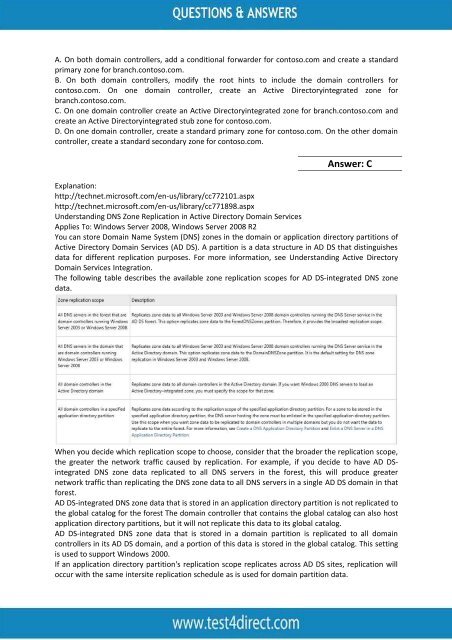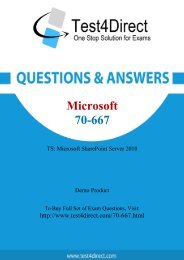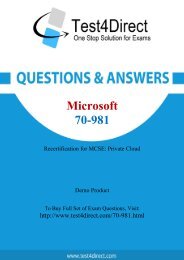70-646 Real BrainDumps
Test4Direct provides latest PDF questions of Microsoft 70-646 exam. You have an opportunity to pass the Microsoft 70-646 exam in one go. Test4Direct is most accurate source to prepare Microsoft 70-646 exam as your success will become site’s responsibility after purchasing 70-646 exam product. There are also lots of discounts and promotion offers that you can avail. Let’s try a free demo http://www.test4direct.com/70-646.html
Test4Direct provides latest PDF questions of Microsoft 70-646 exam. You have an opportunity to pass the Microsoft 70-646 exam in one go. Test4Direct is most accurate source to prepare Microsoft 70-646 exam as your success will become site’s responsibility after purchasing 70-646 exam product. There are also lots of discounts and promotion offers that you can avail. Let’s try a free demo http://www.test4direct.com/70-646.html
You also want an ePaper? Increase the reach of your titles
YUMPU automatically turns print PDFs into web optimized ePapers that Google loves.
A. On both domain controllers, add a conditional forwarder for contoso.com and create a standard<br />
primary zone for branch.contoso.com.<br />
B. On both domain controllers, modify the root hints to include the domain controllers for<br />
contoso.com. On one domain controller, create an Active Directoryintegrated zone for<br />
branch.contoso.com.<br />
C. On one domain controller create an Active Directoryintegrated zone for branch.contoso.com and<br />
create an Active Directoryintegrated stub zone for contoso.com.<br />
D. On one domain controller, create a standard primary zone for contoso.com. On the other domain<br />
controller, create a standard secondary zone for contoso.com.<br />
Answer: C<br />
Explanation:<br />
http://technet.microsoft.com/en-us/library/cc772101.aspx<br />
http://technet.microsoft.com/en-us/library/cc771898.aspx<br />
Understanding DNS Zone Replication in Active Directory Domain Services<br />
Applies To: Windows Server 2008, Windows Server 2008 R2<br />
You can store Domain Name System (DNS) zones in the domain or application directory partitions of<br />
Active Directory Domain Services (AD DS). A partition is a data structure in AD DS that distinguishes<br />
data for different replication purposes. For more information, see Understanding Active Directory<br />
Domain Services Integration.<br />
The following table describes the available zone replication scopes for AD DS-integrated DNS zone<br />
data.<br />
When you decide which replication scope to choose, consider that the broader the replication scope,<br />
the greater the network traffic caused by replication. For example, if you decide to have AD DSintegrated<br />
DNS zone data replicated to all DNS servers in the forest, this will produce greater<br />
network traffic than replicating the DNS zone data to all DNS servers in a single AD DS domain in that<br />
forest.<br />
AD DS-integrated DNS zone data that is stored in an application directory partition is not replicated to<br />
the global catalog for the forest The domain controller that contains the global catalog can also host<br />
application directory partitions, but it will not replicate this data to its global catalog.<br />
AD DS-integrated DNS zone data that is stored in a domain partition is replicated to all domain<br />
controllers in its AD DS domain, and a portion of this data is stored in the global catalog. This setting<br />
is used to support Windows 2000.<br />
If an application directory partition's replication scope replicates across AD DS sites, replication will<br />
occur with the same intersite replication schedule as is used for domain partition data.
















